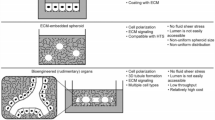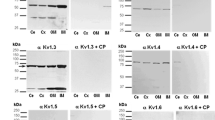Abstract
Madin-Darby canine kidney (MDCK) cells originate from the renal collecting duct and consist of different cell subtypes. We cloned two MDCK cell subtypes denominated as C7 and C11 with different morphology and different function. The two clones maintained their functional differences after cloning. C7 monolayers exhibit a high transepithelial resistance (R te=5648±206 Ω · cm2, n=20) and secrete K+ (ΔK+=1.31±0.08 mmol/l, n=10) into the apical medium. C11 monolayers display a low R te (330±52 Ω · cm2, n=20) and secrete Cl− (ΔCl−= 16.9±1.8 mmol/l, n=10) into the apical medium. Aldosterone (1 μmol/l) stimulates K+ secretion (ΔK+ of 3.58±0.11 mmol/l, n=7) in C7 cells and H+ secretion in C11 cells (ΔpH=0.060±0.007, n=10). Aldosterone-induced stimulation of K+ secretion is inhibited by apical application of amiloride (1 μmol/l). cAMP stimulates H+ secretion in C11 cells (ΔpH= −0.068±0.004, n=10). Furthermore, C7 cells are peanut-lectin(PNA)-negative and exhibit an intracellular pH of 7.39±0.05 (n=7), whereas C11 cells maintain intracellular pH at 7.16±0.05 (n=8) and a major fraction of cells is PNA positive. We conclude that we have cloned two subtypes of MDCK cells which stably express different functional characteristics. The C7 subtype resembles principal cells (PC) of the renal collecting duct, whereas the C11 subtype resembles intercalated cells (ICC) of the renal collecting duct. The C11 subtype seems heterogenous and possibly consists of two subpopulations similar to the α-ICC and β-ICC of the renal collecting duct. The two cloned subtypes could serve as a valuable model to study PC-like cells and ICC-like cells independently.
Similar content being viewed by others
References
Bello-Reuss E (1991) Electrophysiological identification of cell types in cortical collecting duct monolayers. Renal Physiol Biochem 14:1–11
Bowman EJ, Siebers A, Altendorf K (1988) Bafilomycins: a class of inhibitors of membrane ATPases from microorganisms, animal cells, and plant cells. Proc Natl Acad Sci USA 85:7972–7976
Brown CDA, Simmons NL (1981) Catecholamine stimulation of Cl− secretion in MDCK epithelium. Biochim Biophys Acta 649:427–435
Cereijido M, Robbins ES, Dolan WJ, Rotunno CA, Sabatini DD (1978) Polarized monolayers formed by epithelial cells on a permeable and translucent support. J Cell Biol 77:853–880
Dreher D, Rochat T (1992) Hyperoxia induces alkalinization and dome formation in MDCK epithelial cells. Am J Physiol 262:C358-C364
Drenckhahn D, Schluter K, Allen DP, Bennett V (1985) Colocalization of band 3 with ankyrin and spectrin at the basal membrane of intercalated cells in the rat kidney. Science 230:1287–1289
Fejes-Tóth G, Náray-Fejes-Tóth A (1992) Differentiation of renal β-intercalated cells to α-intercalated and principal cells in culture. Proc Natl Acad Sci USA 89:5487–5491
Hamm LI, Alpern RJ (1992) Cellular mechanism of renal tubular acidification. In: Seldin DW, Giebisch G (eds) The kidney: physiology and pathophysiology, 2nd edn. Raven, New York, pp 2581–2626
Kersting U, Wojnowski L, Steigner W, Oberleithner H (1991) Hypotonic stress-induced release of KHCO3 in fused renal epitheloid (MDCK) cells. Kidney Int 39:891–900
Kersting U, Schwab A, Treidtel M, Pfaller W, Gstraunthaler G, Steigner W, Oberleithner H (1993) Differentiation of Madin-Darby canine kidney cells depends on cell culture conditions. Cell Physiol Biochem 3:42–55
Koeppen BM, Stanton BA (1992) Sodium chloride transport. Distal nephron. In: Seldin DW, Giebisch G (eds) The kidney: physiology and pathophysiology, 2nd edn. Raven Press, New York, pp 2003–2039
LeHir M, Kaissling B, Koeppen BM, Wade JB (1982) Binding of peanut lectin to specific epithelial cell types in kidney. Am J Physiol 242:C117-C120
McRoberts JA, Erlinger S, Rindler MJ, Saier MH (1982) Furosemide-sensitive salt transport in the Madin-Darby canine kidney cell line. J Biol Chem 257:2260–2266
Misfeldt DS, Hamamoto ST, Pitelka DR (1976) Transepithelial transport in cell culture. Proc Natl Acad Sci USA 73: 1212–1216
Nakazato Y, Suzuki H, Saruta T (1989) Characterization of subclones of Madin-Darby canine kidney renal epithelial cell line. Biochim Biophys Acta 1014:57–65
Nichols GE, Lovejoy JC, Borgman CA, Sanders JM, Young WW (1986) Isolation and characterization of two types of MDCK epithelial cell clones based on glycosphingolipid pattern. Biochim Biophys Acta 887:1–12
Oberleithner H (1991) Acute aldosterone action in renal target cells. Cell Physiol Biochem 1:2–12
Oberleithner H, Steigner W, Silbernagl S, Vogel U, Gstraunthaler G, Pfaller W (1990) Madin-Darby canine kidney cells III. Aldosterone stimulates an apical H+/K+ pump. Pflügers Arch 416:540–547
Oberleithner H, Vogel U, Kersting U, Steigner W (1990) Madin-Darby canine kidney cells II. Aldosterone stimulates Na+/H+ and Cl−/HCO −3 exchange. Pflügers Arch 416:533–539
Oberleithner H, Westphale H-J, Gaßner B (1991) Alkaline stress transforms Madin-Darby canine kidney cells. Pflügers Arch 419:418–420
Richardson JCW, Scalera V, Simmons NL (1981) Identification of two strains of MDCK cells which resemble separate nephron tubule segments. Biochim Biophys Acta 673: 26–36
Schuster VL, Stokes JB (1987) Chloride transport by the cortical and outer medullary collecting duct. Am J Physiol 253:F203-F212
Simmons NL, Tivey DR (1992) The effect of hyperosmotic challenge upon ion transport in cultured renal epithelial layers (MDCK). Pflügers Arch 421:503–509
Thomas JA, Buchsbaum RN, Zimniak A, Racker E (1979) Intracellular pH measurements in Ehrlich ascites tumor cells utilizing spectroscopic probes generated in situ. Biochemistry 18:2210–2218
Valentich JD (1981) Morphological similarities between the dog kidney cell line MDCK and the mammalian cortical collecting tubule. Ann NY Acad Sci 372:384–405
Van Adelsberg JS, Edwards JC, Al-Awqati Q (1993) The apical Cl−/HCO −3 exchanger of β-intercalated cells. J Biol Chem 268:11 283–11 289
Weiner ID, Hamm LL (1989) Use of fluorescent dye BCECF to measure intracellular pH in cortical collecting tubule. Am J Physiol 256:F957-F964
White S, Boulpaep E, Giebisch G (1992) Differentiated transport properties of primary cultured distal nephron. Cell Physiol Biochem 2:323–335
Wojnowski L, Gaßner B, Steigner W, Oberleithner H (1992) Endothelin-1 blunts transepithelial transport and differentiation of Madin-Darby canine kidney cells. Pflügers Arch 420:508–514
Zeidel ML (1993) Hormonal regulation of inner medullary collecting duct sodium transport. Am J Physiol 265:F159-F173
Zeidel M, Silva P, Seifert JL (1986) Intracellular pH regulation and proton transport by rabbit renal medullary collecting duct cells. Role of plasma membrane proton adenosine triphosphatase. J Clin Invest 77:113–120
Author information
Authors and Affiliations
Rights and permissions
About this article
Cite this article
Gekle, M., Wünsch, S., Oberleithner, H. et al. Characterization of two MDCK-cell subtypes as a model system to study principal cell and intercalated cell properties. Pflügers Arch 428, 157–162 (1994). https://doi.org/10.1007/BF00374853
Received:
Revised:
Accepted:
Issue Date:
DOI: https://doi.org/10.1007/BF00374853




